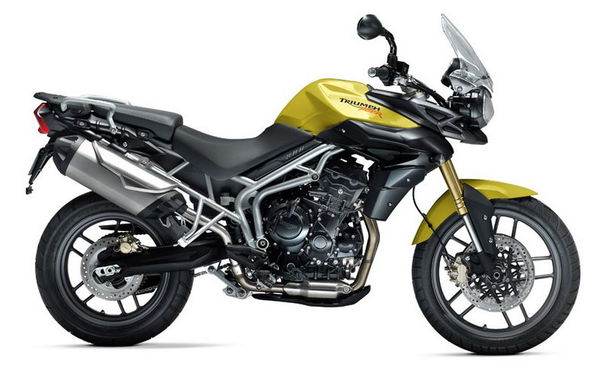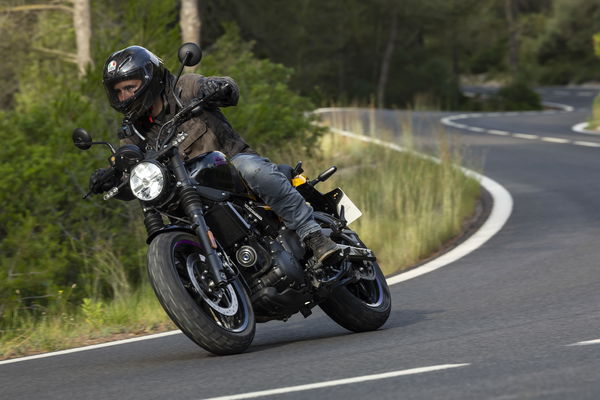Tiger 800 (2011- onwards) review
Triumph's new Tiger 800 enters a competitive market. Ben Cope gives his first opinion.
I'VE JUST FINISHED a day riding Triumph's new Tiger 800. We ride the Tiger 800XC tomorrow. We're based around 30 miles west of Barcelona and have been up in the Montserrat region on some very twisty, slightly wet and bloody cold roads.
The Tiger 800 is at home in this terrain. Infact I imagine the development team had a picture of this region on the wall of their office to keep their focus sharp.

Triumph's new Tiger 800 enters a competitive market. Ben Cope gives his first opinion.
I'VE JUST FINISHED a day riding Triumph's new Tiger 800. We ride the Tiger 800XC tomorrow. We're based around 30 miles west of Barcelona and have been up in the Montserrat region on some very twisty, slightly wet and bloody cold roads.
The Tiger 800 is at home in this terrain. Infact I imagine the development team had a picture of this region on the wall of their office to keep their focus sharp.
The bike is very good, it has lots going for it. There you go, road test over. No, only kidding. The one thing that stands out the most about the Tiger 800 is it's engine characteristics; it's got a wealth of torque and immaculate fuelling. And let's face it, three-cylinder engines naturally offer a good blend of usable drive and top-end, but bad fuelling has been the Achilles' heel of many a modern bike (KTM RC8 anyone?). So getting the fuelling right is important and Triumph have it sorted.
When I first heard about the 800, I wondered why Triumph didn't just stick with the 675 engine but the engine from the Street Triple just wouldn't work as well in this bike. The Tiger 800 does share some engine componenets from the 675, notably the cylinder head and throttle bodies but that's about it.
Not only is the extra capacity welcome, but the bulge of torque is monster. It's like a really, really fit Street Triple low-down. There's next to no jerkiness from the delivery at low revs, making things like roundabouts and hairpin bends really easy to master with no need for clutch slip, just smooth throttle openings. But it's not like a Street Triple at the top-end.
Triumph's new Tiger 800 enters a competitive market. Ben Cope gives his first opinion.
I'VE JUST FINISHED a day riding Triumph's new Tiger 800. We ride the Tiger 800XC tomorrow. We're based around 30 miles west of Barcelona and have been up in the Montserrat region on some very twisty, slightly wet and bloody cold roads.
The Tiger 800 is at home in this terrain. Infact I imagine the development team had a picture of this region on the wall of their office to keep their focus sharp.
The bike is very good, it has lots going for it. There you go, road test over. No, only kidding. The one thing that stands out the most about the Tiger 800 is it's engine characteristics; it's got a wealth of torque and immaculate fuelling. And let's face it, three-cylinder engines naturally offer a good blend of usable drive and top-end, but bad fuelling has been the Achilles' heel of many a modern bike (KTM RC8 anyone?). So getting the fuelling right is important and Triumph have it sorted.
When I first heard about the 800, I wondered why Triumph didn't just stick with the 675 engine but the engine from the Street Triple just wouldn't work as well in this bike. The Tiger 800 does share some engine componenets from the 675, notably the cylinder head and throttle bodies but that's about it.
Not only is the extra capacity welcome, but the bulge of torque is monster. It's like a really, really fit Street Triple low-down. There's next to no jerkiness from the delivery at low revs, making things like roundabouts and hairpin bends really easy to master with no need for clutch slip, just smooth throttle openings. But it's not like a Street Triple at the top-end.
2011 Triumph Tiger 800XC specifications
Engine:
Type Liquid-cooled, 12 valve, DOHC, in-line three-cylinder
Capacity 799cc
Bore/Stroke 74.0 x 61.9mm
Fuel System Multipoint sequential electronic fuel injection
Exhaust Stainless steel three-into-one system with high level silencer
Transmission:
Final Drive X ring chain
Clutch Wet, multi-plate
Gearbox Six-speed
Oil Capacity 3.7 litres 1.0 US gals
Cycle Parts:
Frame Tubular steel trellis frame
Swingarm Twin-sided cast aluminium alloy
Wheels Front 36-spoke 21 x 2.5”, aluminium rim
Wheels Rear 32-spoke 17 x 4.25”, aluminium rim
Tyres Front 90/90 ZR 21
Tyres Rear 150/70 ZR 17
Suspension Front Showa 45mm upside down forks, 220mm travel
Suspension Rear Showa monoshock with remote oil reservoir, hydraulically adjustable preload, 215mm rear wheel travel
Brakes Front Twin 308mm floating discs, Nissin two-piston floating calipers (ABS model available)
Brakes Rear Single 255mm disc, Nissin single piston floating caliper (ABS model available)
Front Master Cylinder Nissin master cylinder, 14mm diameter
Instrument
Display/Functions
LCD multi-functional instrument pack with digital speedometer, fuel gauge, trip computer, analogue tachometer, clock
Other Features
Coded key immobilizer, hand guards, radiator guards, auxiliary power socket, rear rack
Dimensions:
Length 2215 mm 87.1 in
Width (handlebars) 865 mm 34.0 in
Height without mirrors 1390 mm 54.7 in
Minimum seat height 845 mm 33.2 in
Wheelbase 1568 mm 61.7 in
Rake/Trail 23.1º / 91.1mm
Fuel tank capacity 19 litres 5 US gals
Wet weight 215 kg 473 lbs
Performance: (Measured at crankshaft to 95/1/EC)
Maximum power EC 95 PS 94 bhp 70 kW @ 9300rpm
Maximum torque EC 79 Nm 58 ft.lbs @ 7850rpm











